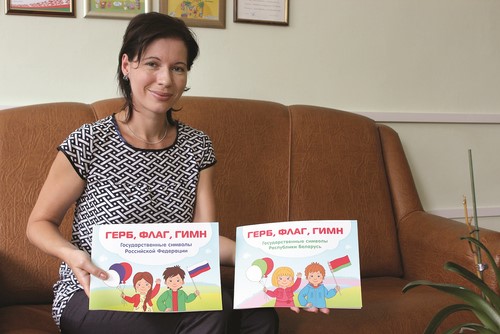Pachatkovaya Shkola Publishing House has joined forces with Russian Petrotsentr Publishing House to realise a unique project, releasing two colour illustrated books for preschool children within the Union State, entitled Coat of Arms, Flag, Anthem. One describes the state symbols of the Republic of Belarus while the other is dedicated to symbols of the Russian Federation, as presented at the 11th St. Petersburg International Book Salon.

“One of the key tasks was to explain the meaning and significance of our flag, coat of arms and anthem in a simple way,” notes Vladimir Malyshev, Director of the House of Writers of St. Petersburg, who took part in the presentation. “Often, an anthem is performed at some event but no one knows all the verses. Meanwhile, in many counties, small children have been taught the words from a young age. It’s very important. For example, in Greece, before classes, children gather at the playground to sing the state anthem, as the flag is raised. Unfortunately, we don’t have this tradition. Therefore, we have this book. ”
“The book also talks about national symbols,” adds Olga Vanina, the director and editor-in-chief of Pachatkovaya Shkola Publishing House. “For Belarus, such symbols are ‘Belarus’ tractors, aurochs and storks, while the Kremlin, birch tree and bear are symbols of Russia.”
Teachers and methodology specialists who worked on the edition have tried to inspire young readers, adding tasks and puzzles to the book, such as guessing the nationality from national costumes. Meanwhile, adults may enjoy finding the pattern of ‘the orient sun’ among samples of national Belarusian ornamentation.
The Russian book includes ‘dot to dot’ drawings, which can then be coloured in, to create a Russian bogatyr knight on horseback, bearing weapons, as depicted on Russia’s coat of arms. Children are invited to create a family tree, with the help of parents and grandparents, gathering their own family history, from photos and letters. Of course, the history of each family is part of the nation’s history. It’s important that children find their own context, through relatives, within history.
The Russian book’s author, Andrey Antonov, noted during the presentation of the project that further editions may be released, to familiarise children with the history and geography of Russia, Belarus and other CIS states. Ms. Vanina believes that the project should continue, noting that her publishing house has experience of successful cooperation with the Union State Standing Committee. They released a guide entitled Polotsk-Smolensk. Landmarks of Common Fate, under the order of the Union State Standing Committee, to mark the 1,150th anniversary of the cities. In addition, they’ve released 2011-2015 Concept of Social Development of the Union State — A New Stage of Formation of the Common Social Space and an edition entitled Union State. Development and Prospects. Pachatkovaya Shkola Publishing House has organised an information project for children, entitled World of Professions of the Union State.
“We’d like to publish a bright and exciting book, accessible to children, about the Union State,” notes the director of Pachatkovaya Shkola Publishing House. “Our countries are efficiently interacting across various spheres and we should tell our children about this.”











